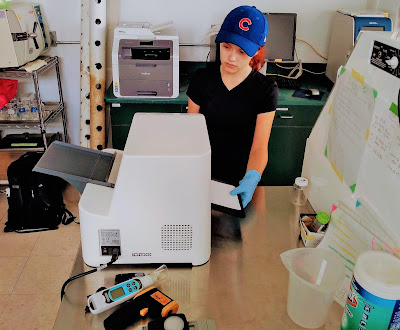 |
| Climate vulnerability map for Assateague. Climate vulnerability is on the left, and ecological value is on the right, with darker colors representing higher scores. |
As I continued my research and dialogue with partners on climate change threats and opportunities for adaptation, I decided to break down climate threats by their impacts: infrastructure, natural resources, human resources, cultural resources, and recreation. Each of the sites that I am working on is very different. Browns Branch Wildlife Management Area has historically been managed as an agricultural area with a small stream running through the site. Pocomoke State Forest is 18,000 acres of non-contiguous forest lands across the eastern shore of Maryland, offering many recreational opportunities, but not many recreational facilities. Assateague on the other hand, is a two mile stretch of dunes, beaches, and campsites on the Atlantic Ocean. It receives over 700,000 visitors every year and is host to many amenities including the beach itself, a restaurant, bike paths, public restrooms, changing areas, a nature center, ranger station, and boat launches. This makes Assateague unique in terms of recreational and infrastructure challenges -- Assateague’s facilities need to support large numbers of visitors while being resilient to worsening storms, increasing hurricanes, changing wind patterns, and increasing temperatures.
 |
| Map of park regions. |
 |
| Sand covering the walkway at Assateague State Park. Photo: Kate Vogel |
So I decided to bring solutions with the help of my mentor. She suggested we could work with the University of Maryland (UMD) Architectural Studio. They have a program, the Partnership for Action Learning in Sustainability (PALS), which connects students with real life projects and aims to find innovative ways to address climate change. We were able to get matched with two architectural studio classes: one to create designs for Assateague State Park’s ranger and camper registration building, which is slated to be reconstructed soon, and the other to redesign the concession stands and day use area, which also need updating. The first studio is taking place this summer, and has already been very eye opening, not only for me as it relates to my project, but for leaders in DNR Parks and Recreation, and Engineering and Construction. Good decisions take time, and that includes formulating plans to create innovative designs and determine which projects should be prioritized first over others. We were lucky in that right before the students visited Assateague, we had actually received the first draft of the state contractors’ designs for buildings. In very traditional drawings, the buildings were elevated and rectangular in addition to appearing more modern than the current building. They were exciting to see - and the students took the drawings even further.
 |
| The ranger station at Assateague State Park. |
In presentations that occurred once every 1.5 weeks, the four UMD students presented their diagrams to a multidisciplinary team of UMD professors, MD DNR staff from Engineering and Construction and Chesapeake and Coastal Services, and JRS architects. Our climate change mission at Assateague State Park is to “to conserve and foster an appreciation of the natural resources of Assateague State Park and to continue to provide substantial recreational opportunities for as long as possible in a sustainable manner.” The students rose to the challenge of making this a reality. Their ideas conceptualized dune migration over time, and they showed how it would be possible to change campground layouts without compromising campsite availability, while allowing dunes to migrate. They proposed new solutions for increasing shading in the day use area, an increasing concern of park staff as temperatures increase and heat stress becomes more common. Students identified opportunities for educational landscapes, where visitors could learn about the history of the land, dune processes, biodiversity, and more. Building designs included passive ways to harness wind and solar energy, while creating an engaging, welcoming, and natural landscape for visitors. Creative elevation designs showcased opportunities for reducing impervious surfaces and increasing ADA accessibility, so that the building will be inclusive for all guests and utilize techniques to reduce flooding on site. Building designs referenced indigenous architecture and prioritized connectivity and flow among office spaces and public spaces.
 |
Sample graphic from Yan Konon, a student with the University of Maryland Architecture Design Studio Credit: University of Maryland Partnership for Action Learning in Sustainability |
Good things take time. Good things also are made possible by collaboration and resource sharing. Climate change is going to require that we think outside of typical design requirements and recognize the need for adaptable designs. As we analyze project designs to respond to climate change, we should think about engaging new and different partners and remember that there is so much more room for creativity, connectivity, and education in our lives, as long as we embrace it.
















